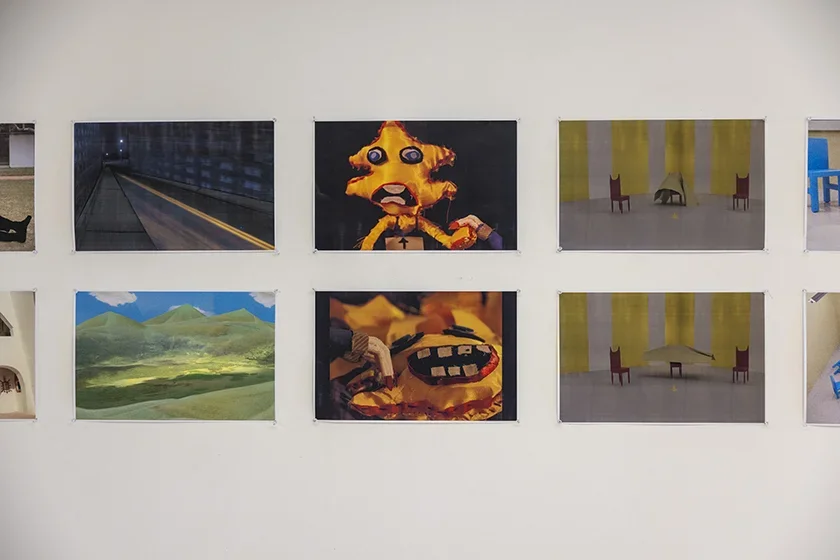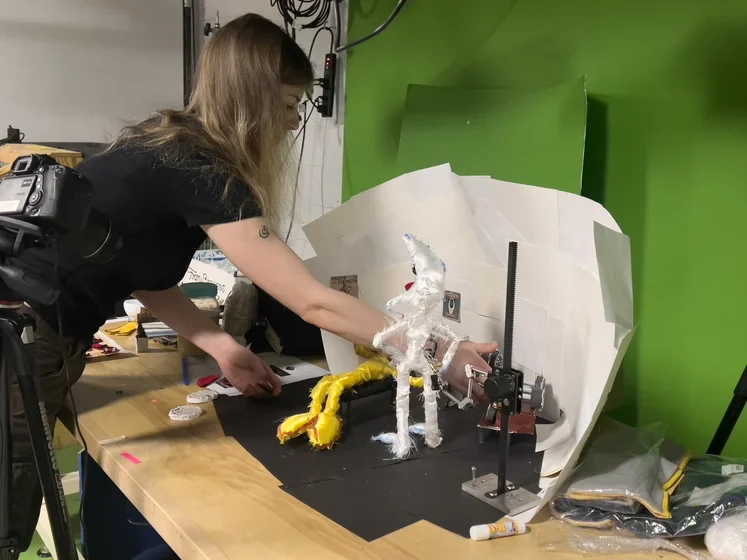Animation at Bennington: Imagination and Experimentation
The juniors and seniors in Sue Rees’s Animations Projects class have walked away with several valuable lessons this term. Stills from their projects are up in an exhibition in the Barn Annex through May 16.
“It’s always wonderful to see work which is personal, individual, and, for the seniors, the culmination of four years,” said Rees. “For the juniors, I love seeing how this work will continue in their last year.”
The Animation program at Bennington blends visual and performing arts and teaches students fundamental techniques such as stop motion, single-cell drawing, model-making, CGI, and more. Using tools like DragonFrame, MAYA, Adobe software, TVPaint, Rokoko Motion Capture suits, laser cutting, green screens, and motion tracks, students create animations inspired by narratives, research, current events, poetry, and visual prompts, all while exploring historical and technical contexts.
Interdisciplinary collaboration is encouraged, allowing students to integrate music, languages, philosophy, biology, and other arts into their work. Emphasizing creativity, expression, and animation’s transformative power, the program culminates each term with a public showing of student projects.
Graduates have gone on to prestigious institutions such as CalArts, the Royal College of Art, University of Edinburgh, NYU Tisch, and the University of Southern California; Graduates are currently holding positions at RISD, Kansas City Art Institute, Paramount Animation, and others places.



Chuna Chugay ’25 is working on an animated documentary from research they did with the during their Newman and Cox Public Action Fellowship in 2023. They made recordings of interviews with students, artists, and survivors of the deportation of Koryo-Saram in eastern Russia in 1937.
“In general, taking classes here and with Sue has shifted my understanding of what's a successful piece,” said Chugay. “I came here with a rigid idea that was formed mostly from watching over-produced works that are done by big companies or big groups of people mostly just to make money. I was exposed here to an independent, alternative animation world that can be way less narrative and way more loose, let’s say, but still as powerful. And I think it reaches out to people in a direct way, in the way that a structured and controlled narrative would.”
Tatiana Dibtseva ’25 has been taking animation courses since her first term. While she is grateful for having been made to explore different techniques through class assignments, she is grateful to spend most of her time now doing the type of animation she likes the best: hand-drawn character animation. She has an ambition to create a pilot episode for a television series. “Gravity Falls was also a senior project for Alex Hirsch, who created it,” she notes.
She had been dreading creating the backgrounds because much of the action takes place in a city. “‘No way I'm drawing the same background all over again for the city,’” she remembered thinking. “So I decided to 3D model it in Blender, which is a free 3D modeling software. All the backgrounds—all the insides, all the outsides—are made in Blender. And it was hard, because I never worked in Blender in my life, so I spent too much time trying to figure it out. Now I have this whole file, a Blender file, where I just moved the camera around and snapped the backgrounds, and then I animated on top of it.”



Violet Glock ’26 studies Visual Arts with a focus in animation, supported by studies in art history and costume history.
“I am doing a study of a girl living in a dystopian world, and I'm interested in the ways in which she copes. She's very unassuming at first, but then you see all the things on her wall that are kind of disturbing,” she explained. “So it's part of the comedy that's revealed as her room is revealed.”
“I've learned so much just by doing it,” Glock continued. “Self-paced work is difficult but important to practice; just like planning for yourself and figuring out actually how long things take. You can't really predict it. I constructed most of the things in the room, which took up a lot of time because I had a clear idea in my head of how I wanted it to look. There’s a lot of trial and error that's important to give yourself grace for because it's just hard. These films are usually made with teams and teams of people. But there are a lot of pluses to working on it by yourself, too, because learning every aspect of the process is important for work in the future where you want to collaborate with those people. Then you understand them better and understand how to communicate with them more efficiently.”
Natalie Bayeslan ’26, a film and animation student, is working on a digital 3D animation using MAYA software. Her project is about grief and the relationship between a father and daughter.
“We used Rokoko motion-capture suits. Me and another actress wore them, and Sue Rees and John Crowe connected them to the computer and made it so our movement connected to the movement of the characters,” she said. “For my senior work, I plan to use the same characters but to make different environments and tell a different story.”



Fíona Thérèse ’25 is a visual arts and education student who hopes to teach young children after graduating from Bennington. She created Mr. Star and Mrs. Moon. “They didn't have names in the beginning. They kind of came about. It was a fun thing to make an object and have it have a body like a star, then make it like a person. And another like a moon. I wanted them to go together,” she said.
“It is fun to experiment with lip syncing. So this term, I'm doing a video with Mrs. Moon singing “Ain't There Anyone Here for Love?” from Gentlemen Prefer Blondes. I like the way the actress from the movie, Jane Russell, carried herself, and I want Mrs. Moon to carry herself in that confident, but also sort of clumsy, type of way.”
"I am getting somewhat more familiar with DragonFrame or more organized, writing notes out about where a scene is and then the ending of that scene, and constructing a world. And also creating a world where they both look like they belong,” Thérèse said.
Linnea Burroughs ’26 is working on an animatic, which is a preliminary version of a movie. “It still has all of the characters and many of the details, but sometimes some of the smoothness of the frames isn't quite there yet. There may not be color and things like that,” said Burroughs. She plans to continue using the style for her advanced work. “Essentially, it allows me to work quicker while still getting something that can be viewed, especially since I'm also going to be working on producing a radio play. I need to be able to do both without burning myself out.”
“I've learned how to pace myself,” said Burroughs. “I had to restart this project three times because it didn't look right. So I had to take a step back and be like, ‘Okay, this doesn't look right. This isn't what I want. We’ve got to start over and try again.’ And as frustrating as that was, I am much more satisfied with the product. I am proud of what I have accomplished, and it's something that I genuinely like looking at and think looks good, and I'm more proud that I took that time.”